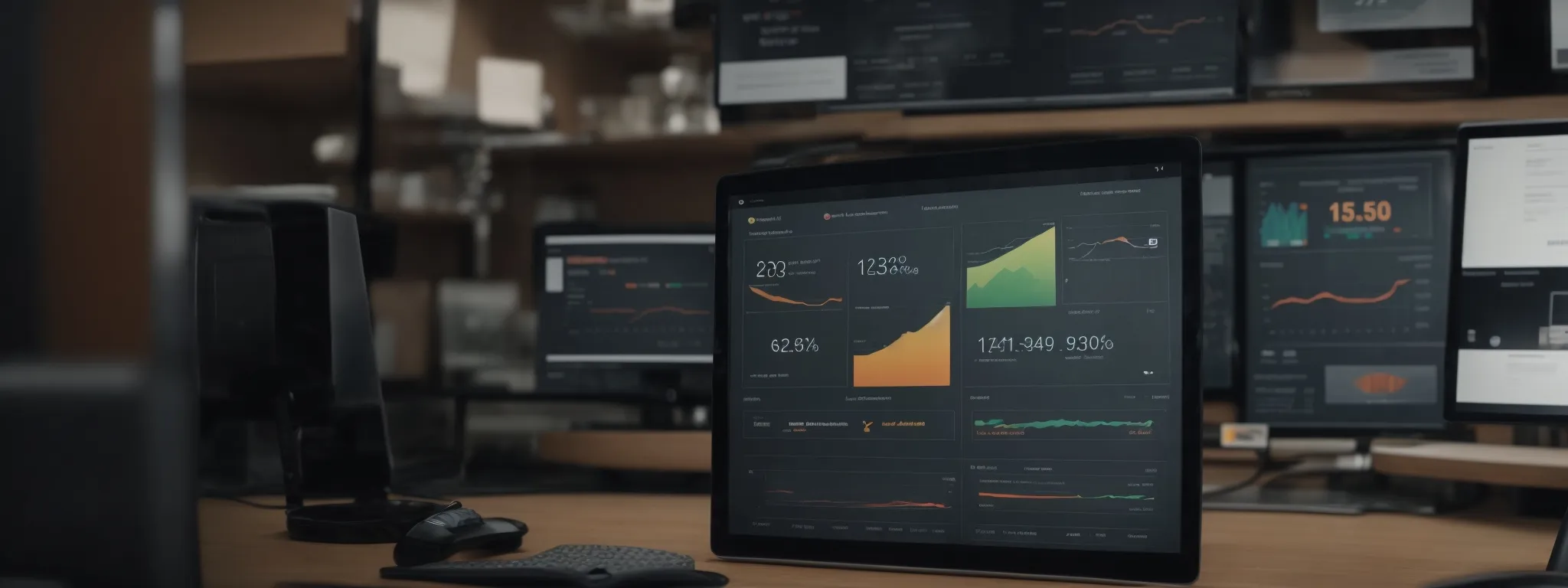Google Shopping Mastery: Ecommerce SEO
Unlocking the Secrets of Google Shopping Mastery for Ecommerce SEO Navigating the intricate web of ecommerce SEO can be daunting, especially when it comes to capitalizing on […]
Unlocking the Secrets of Google Shopping Mastery for Ecommerce SEO
Navigating the intricate web of ecommerce SEO can be daunting, especially when it comes to capitalizing on Google Shopping’s potential to boost an ecommerce site’s visibility and drive traffic.
From meticulously crafting product titles that catapult to the top of the search result page to finessing product descriptions that resonate with both Google’s algorithms and the discerning shopper, the devil is in the detail.
Imagery too plays a pivotal role, with compelling photos often tipping the scales in favor of higher click-through rates.
This guide serves as the map through the terrain of Google Shopping, ensuring that every tweak and tune-up leads to tangible results.
Keep reading to discover how to master Google Shopping for ecommerce SEO, and turn searchers into loyal customers.
Key Takeaways
- Ecommerce SEO Success on Google Shopping Requires Expert Crafting of Product Titles, Descriptions, and High-Quality Images
- LinkGraph’s SEO Services Provide Meticulous Analytics, a/B Testing, and SEO Strategy Adjustments to Improve Product Visibility
- Strategic Integration of SEO and Google Ads Maximizes Campaign Performance and Data-Driven Decision Making
- Continual Refinement and Optimization Are Crucial in Responding to Algorithm Updates and Changing Consumer Behavior
- LinkGraph Leverages Google Merchant Center Tools and Insights to Enhance Ecommerce SEO and Capitalize on Local Shopping Trends
Crafting Product Titles That Rank on Google Shopping

In the dynamic realm of ecommerce SEO, rising to the top of Google Shopping’s results is akin to unlocking a treasure trove for any ecommerce company.
Mastery in this arena begins with the artful science of creating product titles that are both compelling to shoppers and optimized for search engines.
From meticulously choosing target keywords specific to Google Shopping to the strategic placement of these terms within the confines of Google’s title character limitations, the approach to crafting product titles is multifaceted.
Ecommerce sites need not only to assimilate brand-centric keywords for recognition but also to analyze and draw inspiration from competitor titles.
Moreover, this endeavor entails a commitment to continuous testing and refinement, ensuring that each product page resonates with consumers and search engines alike, ultimately boosting visibility and driving conversion rates.
As LinkGraph’s SEO services attest, leveraging these practices can propel a brand to the forefront of digital shelves in the Google Shopping landscape.
Identify Your Target Keywords for Google Shopping
Determining the ideal keywords for Google Shopping is a foundational step in the ecommerce SEO journey. The objective is to select terms that not only encapsulate the essence of the product but also align with the search behavior of potential customers.
Once the cream of the keyword crop is identified, integrating them into product titles demands finesse: ensuring relevance, adherence to Google’s guidelines, and the potential to outshine competing products necessitates precision and focus.
| Keyword Selection Criteria | Importance in SEO | Impact on Google Shopping Performance |
|---|---|---|
| Specificity and Relevance | Increases likelihood of higher search result placement | Directs qualified shopper traffic to product pages |
| Brand and Product Integration | Strengthens brand recognition and product uniqueness | Improves visibility among brand-loyal consumers |
| Competition Analysis | Identifies gaps and opportunities for differentiation | Enhances competitive edge in ad placements |
Optimize Product Titles With Relevant Keywords
Ensuring the integration of pertinent keywords into product titles stands as a cornerstone of LinkGraph’s SEO content strategy, a move that can catapult an ecommerce site into the limelight of Google Shopping searches. This precise alignment between product attributes and search queries not only attracts the right audience but also sets the stage for heightened engagement and improved conversion rates.
LinkGraph’s expertise extends to optimizing every aspect of an ecommerce company’s online presence, including the delicate task of sculpting product titles that balance keyword density with consumer clarity. By seamlessly weaving keywords into titles, they enhance a product page’s potential to garner the attention of both the search engine’s algorithms and the discerning eyes of shoppers.
Balance Brand and Keyword Placement
Navigating the delicate interplay of branding and keyword optimization in product titles is crucial for enhanced visibility on Google Shopping. LinkGraph’s SEO services steer ecommerce businesses through the intricacies of embedding brand elements without overshadowing pertinent keywords, ensuring the product titles resonate with both search engines and the brand’s distinctive identity.
By consciously placing the brand at strategic points and harmonizing it with high-value keywords, businesses can optimize their product titles for a refined balance that conveys brand strength while maintaining SEO effectiveness. This equilibrium supported by LinkGraph’s expertise is essential for capturing the dual attention of Google’s algorithm and the potential customers seeking branded products.
Understand Google’s Title Character Limitations
In the strategic domain of ecommerce SEO, acknowledging and adhering to Google’s title character limitations is a nuanced yet pivotal aspect of crafting search-friendly product titles. Ecommerce entities engaging with Google Shopping must distill their titles to a concise essence, as Google places a cap on character count, compelling marketers to prioritize brevity while ensuring keyword inclusion.
LinkGraph’s adeptness in SEO efficiency shines through its ability to sculpt product titles that not only meet Google’s stringent criteria but also maximize the efficacy within the character constraints. This expertise ensures that every product title is an optimized blend of brand identity and search engine visibility, staying within the bounds set by Google to achieve the greatest impact on shopper queries and search performance.
Analyze Competitor Titles for Insights
An intensive examination of competitors’ titles offers critical insights for any ecommerce entity aiming to refine its approach to Google Shopping. By assessing the terminology and structure competitors employ, LinkGraph’s SEO experts can uncover prevailing trends and keyword usage, which assists in developing distinctive, higher-ranking product titles.
This strategic analysis conducted by LinkGraph is not merely about emulation but rather about identifying opportunities for differentiation within the market. The nuanced understanding gained from competitor research allows ecommerce sites to sculpt product titles that stand out amidst a sea of options, ultimately driving a surge in visibility and shopper engagement.
Continuous Testing and Optimization of Titles
Adaptation and continual improvement are the hallmarks of a successful SEO strategy, especially when it comes to the performance of product titles in Google Shopping. LinkGraph’s SEO experts recognize that customer search behavior and algorithmic preferences evolve, hence the necessity for ongoing refinement of product titles. This steady process of testing various title permutations ensures the match between shopper intent and product offering is optimized.
LinkGraph’s dedication to understanding changing market dynamics is made manifest through its robust A/B testing, where variations of product titles are pitted against one another to glean actionable data. The outcomes of these tests inform a process of iterative enhancements that sharpen the titles for maximum search engine traction and shopper appeal:
- Identification of high-performing keyword combinations
- Analysis of searcher interaction and conversion metrics
- Refinement of title structures for balance and clarity
A cycle of testing, analysis, and adjustment forms the backbone of LinkGraph’s approach to SEO excellence, ensuring product titles not only engage potential customers but also remain in lockstep with the latest search engine trends.
Optimizing Your Product Descriptions for Visibility

Navigating the nuances of Google Shopping, those at the helm of an ecommerce site understand that the journey to the summit of search engine prominence extends beyond the crafting of search-optimized product titles.
It dives deeper into the essence of product descriptions that capture the user experience while also appealing to the search engine’s algorithms.
To successfully pierce through the veil of digital anonymity, mastering the alchemy of constructing descriptions that are both compelling and informative is paramount.
Thus, ecommerce experts must delicately weave strategic keywords, distill key information into potent opening sentences, structure bullet points for clarity, continuously refine based on performance data, and employ rigorous A/B testing to refine click-through rates (CTR).
These elements work cohesively to optimize a product’s visibility, inviting shoppers to not just browse but engage and purchase, embodying the core of an effective ecommerce SEO strategy.
Craft Compelling and Informative Descriptions
In the pursuit of optimizing product visibility in Google Shopping, LinkGraph underscores the importance of creating product descriptions that do more than just inform; they must captivate. Ecommerce sites achieve greater success when they blend rich, descriptive language with strategic SEO practices, ensuring product narratives not only detail features but also echo the search intents of prospective buyers.
LinkGraph champions the approach of using informative and persuasive descriptions to elevate user experience and drive conversions. Their experts meticulously integrate core keywords into engaging storytelling, striking a balance that satisfies the algorithmic preferences of Google Shopping and resonates with the sensibilities of consumers navigating the digital marketplace.
Integrate Strategic Keywords Naturally
LinkGraph’s approach to product description optimization ensures that strategic keywords blend seamlessly into the narrative of each ecommerce product page. Their SEO specialists structure content in a manner that elevates relevance, integrating terms naturally while avoiding the pitfalls of keyword stuffing that detract from the user experience.
The insertion of keywords by LinkGraph’s team appears effortless, resonating with the searcher’s intent and contributing to the organic flow of the prose, ultimately rendering the product descriptions both search engine friendly and user-centric.
Prioritize Key Information in the First Sentences
In the competitive landscape of Google Shopping, the initiation of a product description serves as the gateway to engagement, where every character counts. LinkGraph’s seasoned SEO experts emphasize the importance of highlighting the most vital product features and benefits within the opening lines, knowing that these initial sentences act as a magnet for both the user’s attention and search engine’s crawlers.
Cognizant of the split-second decisions made by consumers, LinkGraph meticulously advises ecommerce sites to begin their product descriptions with compelling, keyword-rich information that instantly conveys the value proposition. This strategy not only garners interest but also aligns with Google Shopping’s algorithm, enhancing the likelihood of a product page ascending the ranks within search results.
Use Bullet Points for Readability and SEO
LinkGraph’s seasoned SEO professionals understand that clarity and conciseness can significantly enhance a product page, and bullet points are an exemplary tool in achieving this. The strategic use of bullet points aids in breaking down complex information into digestible snippets, thereby enhancing readability for the user while ensuring that critical SEO elements, such as keywords, are prominently displayed and easily indexed by search engines.
Furthermore, incorporating bullet points within product descriptions allows LinkGraph to streamline a shopper’s decision-making process. This approach accentuates the product’s key attributes, making it simple for the consumer to scan through the benefits, and simultaneously assists search engines in prominently featuring the product in search results, fostering an optimal balance between user experience and ecommerce SEO performance.
Update Descriptions Based on Performance Data
In the data-driven world of ecommerce SEO, revised product descriptions based on performance analytics can significantly impact visibility on Google Shopping. LinkGraph’s SEO services excel in harnessing data to enhance product narratives, making informed updates that resonate with both the search engine and the discerning shopper.
Continuous refinement of product descriptions leverages the power of consumer behavior insights to optimize each product’s findability and allure. This evolution, guided by performance metrics, cements a product’s place in the competitive market, ensuring it remains aligned with evolving search trends and customer preferences:
- Assessing click-through rates to refine key messaging points
- Monitoring conversion rates to inform targeted keyword placement
- Gleaning user interaction data to optimize information flow within descriptions
LinkGraph’s meticulous analysis provides the foundation for adjustments that adeptly shift with user preferences and algorithm updates. Such agility in SEO tactics underpins the success of an ecommerce company’s presence in Google Shopping, consistently boosting the relevance and performance of its product catalog.
A/B Test Different Descriptions to Improve CTR
In the landscape of ecommerce SEO, the utilization of A/B testing to refine product descriptions is pivotal in amplifying click-through rates on Google Shopping. LinkGraph implements this empirical approach, crafting multiple versions of a product narrative and empirically determining which rendition engages users most effectively and increases the propensity for clicks and conversions.
This scientific analysis, facilitated by the SearchAtlas SEO software, allows LinkGraph to align product descriptions with user behavior and preferences, imperative for navigating the competitive terrain of ecommerce. Through iterative testing, LinkGraph unearths the combination of words that not only informs but also intrigues, carving a path for enhanced visibility and shopper engagement in a crowded digital marketplace.
Enhancing Product Images for Better CTR

In the competitive space of ecommerce SEO, visual elements hold the power to significantly sway click-through rates (CTR) and, by extension, conversions on Google Shopping.
A compelling image can be the decisive factor between a product that lingers unseen and one that captivates potential customers at first glance.
As such, ecommerce sites seeking to refine their presence on Google Shopping must adhere with precision to Google’s stringent image guidelines.
High-resolution, zoomable images, clear thumbnails, and meticulous tests of image styles fundamentally enhance product allure.
Moreover, the careful optimization of image file names and alt texts fortifies SEO efficacy, ensuring products are not only seen but also resonate with the intended audience.
Monitoring engagement metrics serves as the guiding light for iterative image enhancements, anchoring the visual strategy to tangible performance outcomes.
By embracing these visual optimization practices, an ecommerce company positions itself to thrive amidst the visual-centric shopping experiences of today’s digital marketplace.
Follow Google’s Image Guidelines Strictly
Adhering to Google’s image guidelines is a critical step for any ecommerce company seeking prominence on Google Shopping. LinkGraph’s SEO experts understand that high-quality, compliant visuals not only captivate potential customers but also communicate trustworthiness and professionalism, leading to increased CTR and conversions.
LinkGraph ensures that each product image submitted to Google Shopping surpasses the platform’s standards for resolution, background, and scale. This meticulous attention to detail boosts the likelihood of an ecommerce site’s products being showcased effectively in search results, directly influencing shopper engagement and purchase decisions.
Use High-Quality, Zoomable Images
The incorporation of high-quality, zoomable images is a non-negotiable facet of ecommerce SEO that dramatically influences the success metrics on Google Shopping. By offering potential customers the ability to scrutinize product features through high-resolution visuals, ecommerce sites bridge the gap between online browsing and the tangible shopping experience.
Implementing zoomable images signals to the consumer that a company is forthright and detailed in presenting its products, thereby fostering trust and encouraging engagement. This heightened level of clarity not only satisfies the shopper’s need for transparency but also significantly enhances the propensity for increased click-through rates and conversions:
| Image Quality Aspect | Impact on User Engagement | Effect on Search Engine Performance |
|---|---|---|
| Resolution and Zoom Functionality | Enhances product examination, mirroring in-store experiences. | Boosts product page appeal, potentially lowering bounce rates. |
| Transparency and Detail Display | Builds consumer trust, leading to longer page visits. | Encourages positive user behavior signals, aiding ranking factors. |
LinkGraph’s SEO services expertly guide ecommerce companies in optimizing their product imagery, ensuring each visual element aligns with Google Shopping’s rigorous standards and serves to captivate and convert the browsing shopper. The impact of such image enhancements extends beyond mere aesthetics, cementing a product’s presence in the competitive landscape of online retail with potent visual narratives that drive performance.
Choose Thumbnails That Display Products Clearly
For ecommerce companies, the strategic selection of product thumbnails plays a crucial role in improving click-through rates on Google Shopping. Thumbnails act as the storefront window display of the online world, and clear, attractive representations of products are essential to grab the attention of potential customers quickly as they scan through listings.
LinkGraph’s SEO services understand the power of first impressions and relentlessly advise ecommerce sites to employ crisp, well-lit thumbnails that feature the product prominently. Ensuring thumbnail clarity and relevance is not an afterthought but a crucial part of the overall product presentation strategy that can decisively impact customer interaction and interest.
| Thumbnail Feature | Role in User Engagement | Contribution to Google Shopping Success |
|---|---|---|
| Image Clarity | Fosters quick recognition and positive initial response from users | Influences the perceived quality of the listing, affecting ad rank |
| Product Focus | Ensures the product is the central element, eliminating confusion | Improves relevance to user searches, potentially increasing CTR |
Test Different Image Styles and Backgrounds
LinkGraph’s expertise supports ecommerce businesses in discovering the visual preferences of their target audience by recommending the testing of diverse image styles and backgrounds. A careful analysis of these elements can reveal patterns that align with consumer expectations, leading to a finely-tuned visual presentation that enhances click-through rates.
Through A/B testing methodologies, LinkGraph positions ecommerce sites to determine the most effective imagery that connects with consumers, driving engagement and conversions. Variations in lighting, angles, and contextual backgrounds can significantly shift consumer perception and the subsequent performance of Google Shopping ads:
- Measuring the impact of clean white vs. contextual backgrounds on user interaction
- Gauging shopper response to varying product angles and staging
- Quantifying the influence of different image treatments on ad visibility and engagement
Optimize Image File Names and Alt Texts
In the intricate dance of ecommerce SEO, LinkGraph takes the optimization of image file names and alt texts to new levels of precision, recognizing their critical role in enhancing product visibility on Google Shopping. They meticulously craft descriptive, keyword-enriched file names and alt attributes that serve as silent yet potent signals to search engines, driving better indexing and improved search result placement for ecommerce sites.
The proficiency with which LinkGraph handles image optimization goes beyond mere functionality; it strategically aligns with user search behavior. As a result, the alt text acts not only as an accessibility aid but also as an essential component of the product’s SEO footprint, subtly communicating content relevance to both Google’s algorithms and the potential customers navigating this digital realm.
Monitor Engagement Metrics to Inform Changes
LinkGraph’s dedication to optimizing ecommerce SEO extends to the meticulous monitoring of engagement metrics, which serve as key indicators of a product image’s performance on Google Shopping. These metrics, integral to understanding how shoppers interact with product listings, inform tactical changes that can enhance click-through rates, ensuring visual content remains aligned with consumer preferences and behaviors.
The company’s adept use of engagement data to refine imagery is a testament to its strategic approach, prioritizing adaptability within the ever-evolving ecommerce landscape. By analyzing metrics such as click-through and conversion rates, LinkGraph guides ecommerce sites in fine-tuning their visual assets, leading to a polished online presence that captivates and converts with efficiency.
Leveraging Google Shopping Campaign Features

In the convoluted arena of Ecommerce SEO, Google Shopping campaigns stand as a beacon for those striving to achieve digital market dominance.
They offer a myriad of sophisticated features that, when adeptly harnessed, can fortify an ecommerce site’s visibility and attract a revenue-generating shopper base.
Creating well-defined product categories, harnessing merchant promotions, and embracing smart bidding are just the beginning.
Ecommerce businesses that leverage showcase shopping ads, strategically adjust bids by device and location, and scrutinize campaign data stand poised to elevate their online prominence.
In the subsequent exploration, LinkGraph assists companies in navigating through these pivotal tactics to achieve a significant uplift in their ecommerce SEO endeavors.
Define Clear and Structured Product Categories
In the competitive ecosystem of Google Shopping, the definition of clear and structured product categories is pivotal for ecommerce SEO success. LinkGraph’s SEO professionals assist companies in meticulously categorizing their inventory, which not only aids users in finding desired products with ease but also aligns with Google’s algorithms to enhance product discoverability and placement.
Emphasizing precision in classification, LinkGraph facilitates ecommerce sites in crafting categories that reflect the logical hierarchy of their offerings. This structured approach not only caters to a streamlined shopping experience but also enforces relevance in search results, potentially elevating an ecommerce brand’s search visibility and user engagement on Google Shopping.
Utilize Merchant Promotions for Special Offers
At the heart of a successful Google Shopping campaign lies the strategic use of merchant promotions, a tactic that LinkGraph meticulously tailors to an ecommerce site’s needs. The well-executed offer harnesses the potential of special promotions, capturing consumer attention and incentivizing quicker purchase decisions, thus bolstering both traffic and conversion rates.
LinkGraph’s expertise in weaving special offers into Google Shopping campaigns exemplifies the value additions that enhance product appeal. These carefully crafted promotions often tip the balance for consumers comparing products, offering a clear competitive advantage and contributing to increased visibility and improved performance metrics within the ecommerce SEO landscape.
Implement Smart Bidding for Efficient Ad Spend
Smart bidding within Google Shopping campaigns marks the threshold of cost-efficient advertising for ecommerce businesses. With its AI-driven approach, LinkGraph empowers clients to optimize ad spend, delivering ads to the right audience at the right time, effectively maximizing return on investment.
LinkGraph harnesses smart bidding to automate bid adjustments based on a wealth of data points including device performance, time of day, and user intent. This precision ensures that each penny spent is an investment towards higher conversion rates and better overall performance on Google Shopping.
| Smart Bidding Feature | Benefit to Ecommerce Site | Impact on Google Shopping Campaign |
|---|---|---|
| AI-Driven Automation | Optimized budget allocation for maximum ROI | Enhanced targeting that increases conversion opportunities |
| Data-Driven Bid Adjustments | Reduced overhead in manual campaign management | Agile responsiveness to market trends and user behavior |
Make Use of Showcase Shopping Ads for Visibility
In the fiercely competitive arena of Ecommerce SEO, Showcase Shopping ads stand as a powerful tool for brands to amplify their visibility on Google Shopping. These ads, which allow for the aggregation of related products into a single, immersive ad experience, elevate brand presence and enable ecommerce sites to cast a wider net over potential customers searching for a variety of goods.
LinkGraph’s savvy use of Showcase Shopping ads provides ecommerce companies with a dynamic platform to display a curated collection of products, capturing the interest of users with a breadth of options. This strategic placement serves as a visually compelling gateway into a brand’s varied inventory, enticing users to explore and ultimately, increasing the likelihood of user engagement with a company’s full product range.
Adjust Bids Strategically by Device and Location
Strategically adjusting bids by device and location is a key facet of Google Shopping campaigns, offering LinkGraph’s clients the advantage of tailored marketing approaches. Recognizing that user behavior varies across devices and geographical regions, these bid adjustments are crucial to maximizing ad relevancy and reach.
LinkGraph’s SEO services integrate cutting-edge analytics to fine-tune bid strategies, ensuring that ads resonate with local trends and device preferences. This granular control over bidding mechanisms enhances campaign efficacy, leading to optimized spend and amplified campaign performance:
- Identifying device-specific user engagement patterns to inform bid adjustments.
- Analyzing geographical data to allocate budget effectively across regions.
Analyze Shopping Campaign Data to Refine Tactics
At the core of any successful Google Shopping campaign lies a diligent examination of campaign data. LinkGraph utilizes an array of analytics to dissect every facet of a campaign’s performance, enabling ecommerce SEO specialists to pinpoint areas in need of optimization and adjust strategies accordingly.
Refining ecommerce SEO tactics is an ongoing process bolstered by LinkGraph’s comprehensive analysis of shopping campaign metrics. This scrutiny allows for informed decision-making, transforming data insights into actionable improvements that align perfectly with a company’s objectives and market responsiveness:
- Monitoring click and impression metrics to evaluate ad reach and consumer interest.
- Assessing conversion rates to identify and bolster high-performing ads.
- Analyzing return on ad spend (ROAS) to ensure cost-effective campaign management.

Charting a course through the intricacies of Google Merchant Center can transform an ecommerce site’s trajectory, elevating product listings from the depths of anonymity to the summit of visibility in Google Shopping.
Mastery within this digital bazaar is not about mere participation; it involves strategic management of Merchant Center accounts, meticulous product feed optimizations, and prompt resolutions of errors.
Practitioners who deploy feed rules skillfully and leverage insights and local ad services provided by Google, stand to unlock unprecedented growth opportunities.
LinkGraph’s seasoned experts guide clients through the nuances of these pivotal tools, ensuring that every adjustment is a step towards dominating the digital marketplace landscape.
Set Up Your Merchant Center Account Correctly
Securing a robust foothold in Google Merchant Center is imperative for ecommerce companies eager to excel on Google Shopping. LinkGraph’s SEO expertise is instrumental in setting up Merchant Center accounts with precision, ensuring that product feeds are seamlessly integrated and validated, paving the way for ad campaigns that resonate with Google Shopping’s algorithms and consumer searches.
Professional setup revolves around meticulous attention to detail, from accurate tax settings to shipping configurations, each contributing to the accurate representation of ecommerce offerings. A precisely arranged Merchant Center account, as honed by LinkGraph’s SEO professionals, lays a solid foundation for ecommerce products to thrive within the competitive ecosystem of Google Shopping.
Keep Your Product Feed Accurate and Up-to-Date
Maintaining the precision of your product feed is paramount for ecommerce SEO success on Google Shopping. LinkGraph’s SEO services champion the importance of real-time inventory updates, ensuring that product availability, pricing, and details are consistently in sync with the ecommerce site’s actual offerings, an approach that keeps search listings accurate and trustworthy.
LinkGraph’s meticulous oversight extends to periodic scrutiny of product identifiers and descriptions, aligning a brand’s online catalog with Google’s evolving guidelines. Such diligence reinforces product relevance and discoverability, preventing discrepancies that could hinder the consumer’s path to purchase and affect the overall health of an ecommerce company’s SEO strategy on Google Shopping.
Address Errors and Disapprovals Promptly
Swift action on errors and disapprovals within Google Merchant Center is crucial for maintaining the integrity of an ecommerce SEO strategy. LinkGraph’s experts understand that immediate rectification of these issues safeguards against interruptions in product visibility on Google Shopping.
Discrepancies in product data can lead to disapprovals that stymie an ecommerce site’s performance; thus, LinkGraph emphasizes the rapid resolution of such setbacks. Their vigilance ensures that any barriers to a product’s listing visibility are quickly addressed, preserving the seamless shopping experience for users:
| Error/Disapproval Category | Impact on Google Shopping Listings | Restoration Strategy |
|---|---|---|
| Price Discrepancies | Limits product listing visibility | Prompt updates to reflect real-time pricing |
| Inventory Mismatches | Causes potential shopper frustration | Regular syncing of stock availability |
| Non-compliance with Policies | Leads to listing removal or suspension | Adherence to Google’s updated guidelines |
Use Feed Rules to Enhance Product Data
Optimizing product data with feed rules is a nuanced strategy that yields significant benefits in ecommerce SEO for Google Shopping. Feed rules allow LinkGraph’s experts to automate enhancements in product feeds, tailoring titles and descriptions with pinpoint accuracy to match search queries and improve listing prominence.
These customizations, robust in their ability to drive relevancy, act as a beacon within Google Merchant Center, guiding products to the forefront of shopper searches. Thoroughly leveraging feed rules results in enhanced search alignment and increased visibility, reinforcing ecommerce success:
| Feed Rule Element | SEO Benefit | Impact on Google Shopping |
|---|---|---|
| Title Optimization | Boosts relevance to consumer searches | Improves product listing positioning |
| Description Refinement | Enhances detail and keyword richness | Aids in higher search result visibility |
| Category Mapping | Ensures accurate product classification | Fosters more targeted shopper discovery |
Test Merchant Center Features Like Market Insights
Exploring the capabilities of Google Merchant Center, savvy ecommerce brands unlock a treasure trove of insights through features like Market Insights. LinkGraph’s expertise navigates these analytical layers, procuring data that can redefine an ecommerce SEO strategy, sharpen targeting, and enhance understanding of the competitive landscape in Google Shopping.
By capitalizing on Market Insights, LinkGraph equips ecommerce entities with the foresight needed to stay ahead of ever-shifting market trends. The actionable intelligence garnered supports strategic decision-making, allowing for precision in product positioning and bid management within the dynamic Google Shopping environment.
Explore Google’s Local Inventory Ads Service
LinkGraph’s command of Google’s Local Inventory Ads Service equips ecommerce businesses with the tools to connect the digital and physical shopping realms. By enabling merchants to showcase available products at nearby locations, this service fosters an intricate bond between online browsing and in-store purchases, a crucial differentiator in today’s hybrid retail landscape.
This integration of locality into an ecommerce SEO strategy by LinkGraph serves to drive foot traffic and strengthen local brand presence. Their proficiency transforms geo-specific shopping queries into tangible opportunities, amplifying consumer convenience while achieving elevated search engine outcomes for an ecommerce company’s products.
Monitoring Analytics to Drive Google Shopping Success

Effective analytics monitoring serves as the compass guiding ecommerce sites through the tumultuous sea of Google Shopping, where insights spell the difference between obscurity and prominence.
Companies leveraging LinkGraph’s SEO services gain unparalleled access to state-of-the-art tools and strategies, vital for navigating this online retail space.
It starts with fundamental setup, tuning the sails of Google Analytics for precise e-commerce tracking, progressing to meticulous mapping and following pre-determined Key Performance Indicators.
Skilled at distilling vast oceans of data into actionable intel, LinkGraph enables businesses to segment data for granular analysis and swiftly identify shopping behavior trends that inform tactical maneuvering.
By interlinking with Google Ads, their approach offers a holistic view of campaign performance, enhancing decision-making and fostering agile adaptations to the constantly evolving waves of shopping seasonality.
Set Up Google Analytics for E-Commerce Tracking
Preparing Google Analytics for e-commerce tracking constitutes a vital move for businesses intent on capturing the breadth of their customer’s online journey. LinkGraph’s expertise in setting up this analytical framework ensures that every click, page view, and transaction is meticulously recorded, serving as a digital ledger of consumer behavior for ecommerce sites on Google Shopping.
This precise configuration by LinkGraph establishes a robust foundation for advanced data-driven decision-making. Tracking metrics such as transaction values, conversion rates, and shopping behavior patterns empowers businesses to craft targetted SEO strategies, enhancing their prominence within the competitive digital marketplace.
Define and Track Key Performance Indicators
The bedrock of any successful ecommerce SEO strategy for Google Shopping lies in the meticulous definition and tracking of Key Performance Indicators (KPIs). LinkGraph’s forensic approach to KPI analysis affords ecommerce sites a comprehensive view of performance, ensuring that strategic decisions are governed by data, not conjecture.
Responsive to shifts in consumer patterns and algorithmic changes, LinkGraph’s KPI tracking brings clarity to complex data landscapes, allowing for nimble tactical responses and optimization of marketing channels to meet predefined business goals:
- Measuring conversion rates to evaluate the effectiveness of SEO initiatives.
- Assessing average order value to understand consumer purchasing behaviors.
- Tracking return on ad spend (ROAS) for financial accountability.
Segment Data for Insightful Performance Analysis
In the intricate landscape of Ecommerce SEO, segmenting analytical data carves out a pathway to truly insightful performance analysis. LinkGraph’s strategic segmentation of user data allows ecommerce sites to distinguish between various consumer demographics, behaviors, and engagement patterns, painting a granular picture of the audience landscape.
This level of detailed analysis facilitates an understanding of how different market segments interact with a product listing or campaign, enabling LinkGraph’s clients to tailor their strategies for maximum impact and relevance:
| Market Segment | Customer Behavior Insights | Adapted Strategy Impact |
|---|---|---|
| Demographics (Age, Gender) | Unveil preferences and purchasing power | Campaigns tailored to demographic trends show improved engagement |
| Geographical Location | Highlight regional shopping trends and seasonality | Geotargeted promotions lead to higher conversion rates |
| Device Usage | Indicate shopping habits on different devices | Optimized user experience by device enhances CTR and sales |
With such precise targeting, the ecommerce company positions itself to strategically address its audience’s needs, driving increased relevance and conversions on Google Shopping. The expertise provided by LinkGraph in segmenting and deciphering data empowers companies to optimize their online storefronts, ensuring the right products reach the right consumers effectively.
Pinpoint and Act on Shopping Behavior Trends
In the quest for ecommerce SEO supremacy, astute monitoring of shopping behavior trends is essential. LinkGraph’s nuanced analytics permit businesses to detect and act upon emergent patterns in consumer behavior, enabling real-time optimization of Google Shopping strategies.
Their decisive application of insights ensures that ecommerce entities remain agile, promptly adjusting to shifts in shopper dynamics to maintain a competitive edge in the market:
- LinkGraph leverages data to refine targeting parameters, thereby capturing the most relevant audience segments.
- They identify trending products or categories, advising clients to bolster these areas with increased promotional focus.
- By recognizing shifts in consumer preference or buying behavior, LinkGraph helps businesses to anticipate and respond to market demands proficiently.
Integrate With Google Ads for Comprehensive Data
Integrating Google Ads into an ecommerce SEO strategy unlocks a comprehensive suite of data that enhances every aspect of a Google Shopping campaign. LinkGraph’s adept handling of this integration provides clients with actionable insights, allowing them to fine-tune their campaigns for improved visibility and conversion rates.
This convergence of Google Ads with Google Shopping analytics, orchestrated by LinkGraph, ensures that campaigns are backed by a data-rich perspective, which is indispensable for making informed decisions. The resulting synergy between paid search and organic efforts cultivates an analytics-driven approach that propels ecommerce success.
Regularly Review and Adjust for Shopping Seasonality
Recognizing the ebb and flow of Google Shopping’s seasonal trends is a strategic imperative, and LinkGraph’s SEO services excel in equipping ecommerce sites to navigate these periodic shifts. Their vigilant review and calibration of SEO tactics in alignment with holiday peaks and off-season lulls ensure that ecommerce clientele maximize visibility and capitalize on increased shopper activity.
Through LinkGraph’s expert guidance, seasonal adjustments are not only responsive but also proactive, allowing ecommerce businesses to stay ahead of market trends. This includes anticipating changes in consumer demand and adjusting bidding strategies and campaigns accordingly, thus securing sustained success throughout the shopping year.
Conclusion
Mastering Google Shopping is essential for ecommerce success, and it hinges on an intricate blend of SEO strategies.
By crafting well-optimized product titles and descriptions, leveraging high-quality images, and meticulously managing Google Merchant Center, businesses increase their visibility and attract more customers.
Employing smart bidding strategies, leveraging campaign features like Showcase Shopping ads, and regularly analyzing data for insights into shopping behavior are crucial for driving targeted traffic and boosting conversion rates.
Continuous optimization and adaptability to consumer and market trends are key.
LinkGraph’s expertise equips businesses with the necessary skills and knowledge to navigate the complex landscape of ecommerce SEO, ensuring they not only remain competitive but also maximize their potential for sales and growth on Google Shopping.












































































